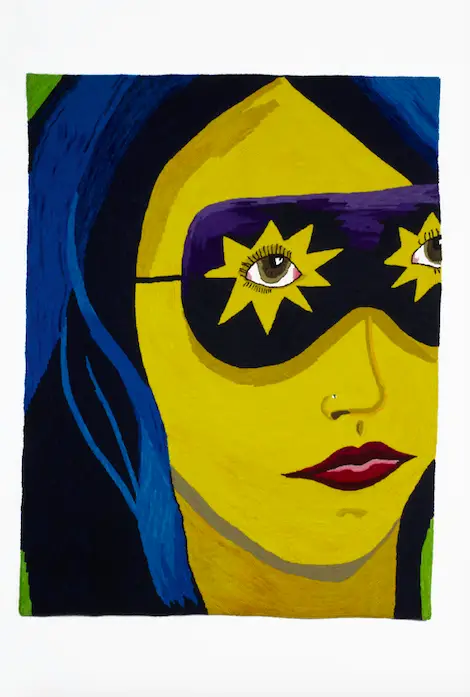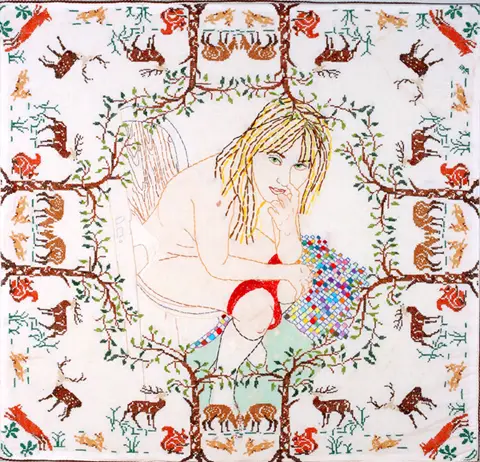Liz Alpert Fay began her studies at Philadelphia College of Art in 1976, and then received a BAA in Textile Design from The Program in Artisanry at Boston University in 1981. Since then and for seventeen years Liz has created art quilts, exhibiting nationally, and in Japan. We are so pleased to have caught up with Liz to find out more about her diverse practice.

Artist Statement
The beauty and simplicity found in nature continues to inspire me. Memories of places I’ve been and things that I’ve seen spark my desire to record my thoughts and feelings in a visual way.
I find my mind often forms it’s own images, trying to capture the essence of how I feel in a particular place, and the surprise and elation I experience when encountering something unexpected, unusual or strikingly beautiful.

Although nature is my main source of inspiration, some of my pieces are purely explorations in color. Others tell stories, reflect my views on life, or enable me to comment on issues that are important to me.
Since 2004 I have been creating large-scale portraits of women I know and admire. The series will be completed in 2025 and will go on exhibit in 2026.
In essence, like most artists, I find each work reflects my thoughts and inspirations at the time of its creation.

How did your technique evolve?
The technique of traditional rug hooking is one of the very few art forms that originated in this country and was not brought over from Europe. Early settlers hooked precious scraps of fabric into burlap feed sacks previously used to feed their animals. These early rugs warmed dirt floors and were also hung on the walls of log cabin homes to block drafts.

I use this traditional art form as the basis to create more contemporary art. My hand hooked rugs tell stories, reflect my views on life, and enable me to comment on issues that are important to me. I aim to challenge conventional ideas of what a rug is and how it functions.
I create pieces with unusual shapes, irregular edges, and sometimes cut into the body of the piece, to expose the floor beneath. Experimenting with unusual or unexpected materials is also something I enjoy. I like the idea of generating interaction with a piece as well as producing a decorative object.

Many crafts are facing extinction due to people simply not being trained in the skills to carry them forward. There is something so poignant about Liz narrating contemporary stories with a traditional medium from her homeland.
Where do you think your creativity is taking you?
Since 2004 I’ve been working on a series of sixteen hooked, larger- than- life portraits of women I know and admire. The series will be completed in 2025, and I’m presently seeking venues to exhibit this work.
So far I have secured two solo exhibitions. The Holter Museum of Art in Helena, Montana, and the Wisconsin Museum of Quilts and Fiber Arts, in Cedarburg, Wisconsin. Both exhibits will be in 2026.

Hand crafts take time and so, by giving herself a distant deadline must certainly open Liz up to think broadly with her craft, committing to grand outcomes – we can’t wait to see how these exhibitions come together over the next few years!
Want To Stay At The Edge?
What other artists inspire you?
Alexander Calder, for his amazing imagination and whimsical creations, and Emily Carr for her vibrant use of color, and her ability to show the spiritual qualities of nature in her paintings.

What is your favorite tool to use in your practice?
There are four basic tools I use every day in my practice. My hooking frame, hook, scissors and a cutter that works like an old-fashioned pasta machine to cut strips of wool. All are necessary tools to create my hooked art.

Can you share one creative tip?
If you take a photo of a work in progress on a smart phone and change it to grey scale, this enables you to see the values in the artwork, and whether you are successful in creating a desired depth of field.

This is a great tip, it can be difficult to have perspective when you have been intensely working on the same piece. Using a grayscale filter is a way to look at your work with fresh eyes – a tip I will certainly be trying myself.
Thank you so much to Liz for taking the time to interview with us, hopefully we will catch up again when the portraits of inspirational women series is complete! For more, make sure to head to Liz’s website and follow her on Instagram.




